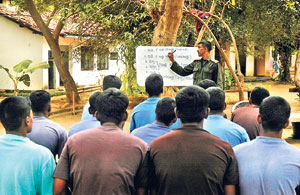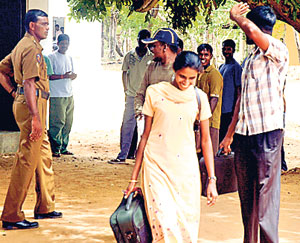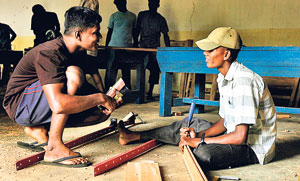Tiger guerrillas wanted the 15-year-old daughter of the house, but the family could not bear to part with her. However, since one child per family had to be “sacrificed” to the movement, 17-year-old *Rajah volunteered to take the place of his sister.
He was trained for 20 days in the use of weapons and then sent to the warfront. That was in 2006.
“I grew up in Jaffna, I was simply at the wrong place at the wrong time,” says the youth who has still managed to retain an air of innocence and gentleness after all he has been through.
 |
| Major Suraweera |
His family was trapped in the Wanni until recently and Rajah managed to rejoin his family and flee to government-controlled areas.
They escaped together from the no-fire zone but got separated when they scattered to avoid being shot by desperate LTTE cadres who were firing indiscriminately at the escapees. Ever since his 16-year-old brother has been missing and Rajah fears that his brother may have been killed in the firing.
Rajah, his parents and his two sisters managed to flee and make their way to the Arunachalam camp in Vavuniya. Rajah surrendered on his own accord to the army and was brought to the Welikanda Rehabilitation Centre in Polonnaruwa.
His mother passed away on April 22 of a contagious fever at the IDP camp. He was not allowed to attend her funeral as the rules require an inmate to stay within the rehabilitation centre premises for one year. He has had no contact with the rest of his family in the IDP camp and he has now received a letter informing him that his father and one of his sisters have also fallen prey to the same fever that took his mother away.
“When they tried to come out of the camp to visit me they were refused permission. They know where I am, I wish they would at least call me,” he said.
He, like many others in the camp, speaks well of the facilities and how they are treated by their trainers but they are unhappy that they have to live far apart from their families for a long period.
“If we have to be sent to rehabilitation centres, at least send us to ones closer to home so that our relatives can visit us,” was the plea of many, including Rajah, as coming to Polonnaruwa is beyond the means of most of their families.
Major B. P. Jayalal Suraveera, commanding officer of the centre has already made inquiries regarding the possibility of sending Rajah to the camp in Tellipalai, in Jaffna.
 |
| Learning Sinhala: Outdoor classes for the inmates |
“Rajah has already made a request in this regard and we are trying our level best to accommodate his wishes,” he said.
As if long starved of a sympathetic ear to hear their tales of woe, the surrendees crowded around to tell us their stories, each traumatic and pitiful but all similar — forced conscription, inadequate training before being marched off to the warfronts and fear of surrendering to the military being identified as an ex-LTTEer, although many had not joined the LTTE voluntarily. Although this fear has subsided to a great extent they now have the additional pain of having little or no information on their kith and kin in IDP camps.
Among the voices clamouring to be heard was that of *Ganesh, who has suffered injuries on his arms, head and even on his torso – all injuries from shelling. He broke down as he related how his parents died during the recent shelling and the last he knew of his four younger siblings was that they were taken to Wanni Hospital to be treated for injuries from shelling.
“Their condition was serious at that time and since then I have had no news of them. Please help me get information on where they are and how they are doing,” he pleaded tearfully. They are not only anxious about the well-being of the loved ones but they also worry that their parents must be anxious not knowing what has happened to them.
“We lack nothing facility wise here but we worry about our aged parents who are probably suffering in the camps. Some angry inmates said the LTTE should never have been allowed to treat the Tamil civilians in such a ruthless manner and terrorism of such brutality should never be allowed to raise its ugly head again.
In the last days of the military onslaught, the LTTE was so desperate that it was conscripting civilians who had just one day’s military training.
“They showed me how to open the gun and reload and that was it and they sent me into the thick of the battle,” shouted one. “I had no idea what to do, I just threw the gun and ran and somehow miraculously escaped,” he said.
About the camp |
Name : Protective Accommodation and Rehabilitation Centre
Location: Senapura, Welikanda, Polonnaruwa District
Extent of camp: Seven and a half acres
Established: August 2008, to rehabilitate captured or surrendered LTTE cadres
Origin: Started with 25 inmates
Current status: 145 inmates
Progress: 189 ex-militants have completed training. |
Some are obviously traumatized and need long sessions of counselling while others despite all they have gone through, manage to be positive and can’t wait to get on with their lives.
“We spent one month in custody after we surrendered before being brought here. We were terrified of how we might be treated because the LTTE had tagged us with its name even though we did not join voluntarily. But here, we are treated with kindness and respect and we have been assured that we will be able to lead trouble-free lives when we leave here. This has brought us great peace of mind,” said one inmate and his sentiments were what we heard from many others when questioned on how they were being treated.
Major Suraweera, is quite aware of the initial feelings of fear and uncertainty the inmates go through as they come to the rehabilitation centre. “We have built a Hindu Kovil, a Buddhist Temple and a Church on the premises. The first sight that greets a nervous ex-cardre as he alights from the bus are these places of worship. These help to relieve his fears to a great extent,” he said.
According to him, most of the inmates are religious in spite of, or perhaps because of, all that they have been through. “Most of them have a firm belief in a benevolent God, who will take care of their troubles,” he said adding that he always made it a point to personally welcome the new arrivals speaking to them in Tamil so that their first impression of an authoritative figure in army uniform is a good one. “This does a lot towards changing their negative impressions about us and helps to build up their trust in us,” he said.
According to the major, he strives to be both a disciplinarian and approachable friend to the inmates. The educational background of the ex-cardres is diverse, ranging from the most rudimentary to those who have qualified to enter university. The camp aims to provide them with basic education and vocational skills. However, catering to such a disparate group of people is not easy, according to Major Suraweera. The inmates are taught English, Sinhala, History, Geography and computer science. They are also given training in masonry, carpentry, house-keeping skills, so that they might have better opportunities for employment and reintegration into society once the rehabilitation period is over.
“We try to cover three main fields – basic education, vocational skills and attitudinal development. We have only one instructor. W.M. Appuhami from the Polonnaruwa Technical College, to teach the inmates carpentry, masonry and plumbing. He is not conversant in Tamil but he has managed to circumvent this issue and has established a rapport with the inmates. It would be ideal if we had instructors conversant in Tamil.
It is also Major Suraweera’s dream to have a computer lab within the premises soon. With a diploma in IT from the Kotelawala Defence Academy, he himself teaches the students computer science but there are not enough computers. “When there were only 25 inmates, I allowed them to practise on my office PC, but now the number has grown to 146 and it’s not possible.
“I live away from my family, so I consider these young men my children and do all that I can for them – from instructing and advising them as their commanding officer and teacher, to acting as a parental figure where necessary such as taking them to the doctors and generally doing all I can to ensure their well being,” he said.
It was Major Suraweera who signed in the place of a parent for the university application of one trainee, S.Ruban. He had passed his A’ Levels with flying colours but had then been forcibly recruited by the LTTE from Kilinochchi. Now he has been given a chance to pursue his dream of higher education and authorities have done all they can to facilitate the process. Ruban currently puts his knowledge to good use as editor of their in-house magazine, but hopes that a new life awaits him.
*(The names of the
inmates have been
changed on request)
Three cadres, three different tales
One of the inmates at the camp, *Krishna, has become so proficient in Sinhala that he is being called on often to be a translator by the trainers. The 21-year-old had been conscripted just before sitting for his O’Level exams from the Batticaloa area. He had always had a passion for IT and had planned to become a professional some day, a dream he hasn’t given up on. Unlike the others, however, he was not embittered by his conscription. He had worked in the LTTE office. He had never seen the battlefield and was not as traumatized or angry like the others.
 |
| One of the inmates leaving after completion of the programme |
He has successfully completed his one year in Welikanda, where he earned the respect of his trainers and is now ready to leave to a western country where he hopes to start a new life.
One of the few members in the centre who wasn’t forcibly conscripted is *Selvam. “I was just 13 at the time (1993),” he said. “Five of us were returning from school when the LTTE called us to join it and we threw away our school bags and joined them.” Asked what had prompted him to join so young, he replied with a grin that it was just the thrill of the moment. He and his friends had found it all very exhilarating. Of the five, two have since died in action and one left the movement long ago to go abroad. The other one is also in a rehabilitation centre elsewhere. Selvam had been given intensive training for three years before being sent into battle which he claims he was not at all afraid of.
“When you are young, you don’t fear death. It was only after I got married during the ceasefire and had a daughter that I started being concerned for my life and that too was only for my wife’s and child’s sake. That’s why I surrendered, not because I wanted anything for myself but because I felt the need to ensure that my wife and five year-old-daughter did not suffer because of me. They should be allowed to lead a hassle-free life.” Selvam was a hard core member of the LTTE who rose to the position of major within the outfit.
* Pillai has just completed the one year programme at the rehabilitation centre and is looking forward to joining his wife and daughter in an IDP camp. His relatives from Trincomalee came to take him to his wife and daughter. He is all smiles at the prospect or rejoining his family, even though it is at an IDP camp. He apparently shaved his head and disguised himself to escape the clutches of the LTTE . His only concern is about possible reprisals from former LTTE cadres who may be at the IDP camp.
There should be legal process along with rehabilitation
Ex-LTTE cadres who were heavily involved in the movement’s activities should be dealt with legally, parallel with the rehabilitation process, a government official said.
 |
| Learning skills that will help them when they step out into society. |
Speaking to the Sunday Times, Commissioner General of Rehabilitation Suhada Gamlath said, among the batches of cadres who surrendered in the last few weeks of the conflict, there were hard core members who were known to have shot at fleeing civilians at point blank range and others who had committed acts of atrocities.
These instances should be identified and the culprits dealt with legally as well as being rehabilitated.At present there are about 11,000 ex-cardres awaiting rehabilitation, he said.
“The process of channeling them through rehabilitation is going to be hectic,” Mr. Gamlath said, adding that the current centres were filled to capacity.
He said there were plans to open four new centres to accommodate the recent surrendees who wish to be rehabilitated. Of the four, one rehabilitation centre is to be opened at the Vavuniya Co-operative School building while another only for male surrendees, is to be set up at the Technical College building in Nellukulam, Vavuniya. |




